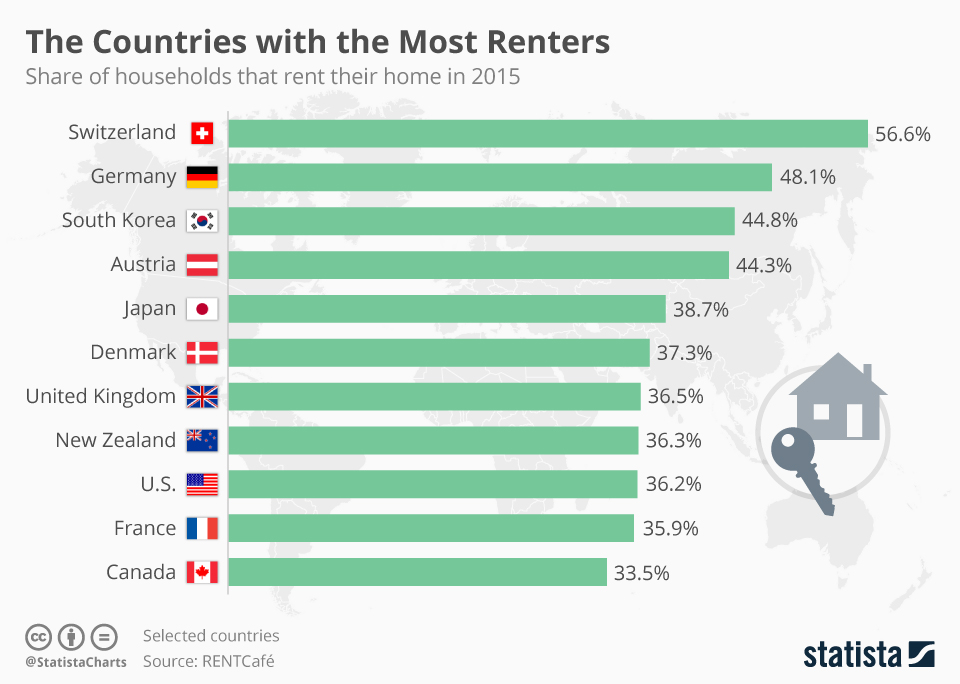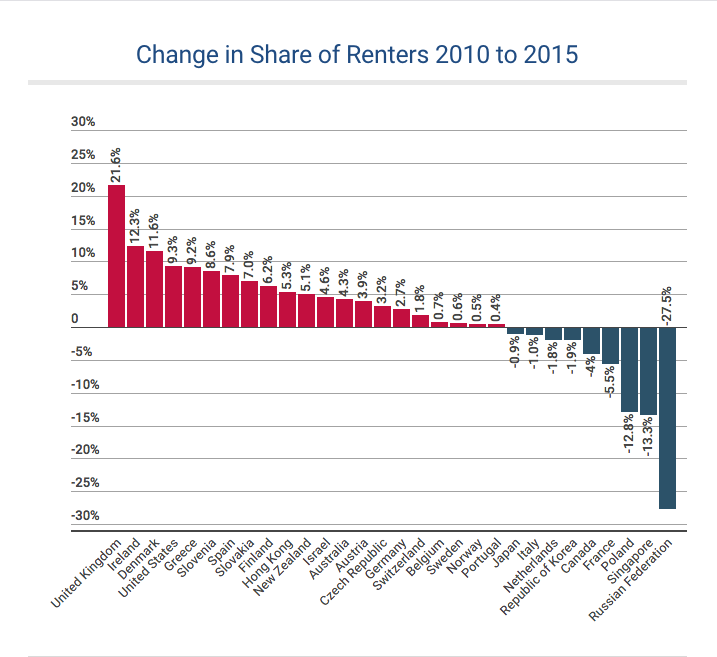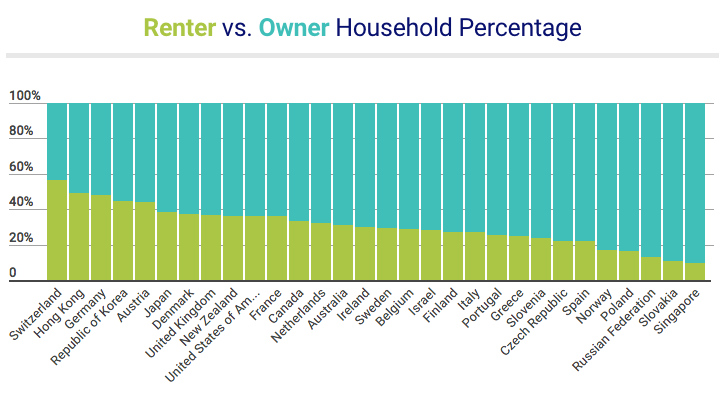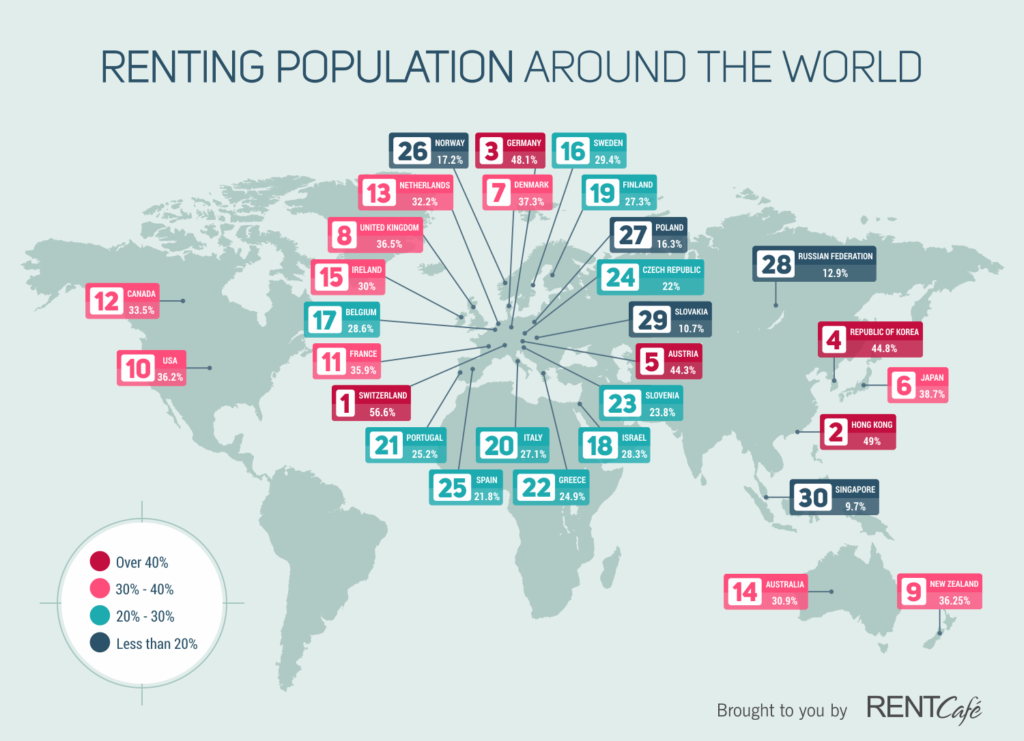One of the most common refrains among electric vehicle (EV) advocates around the world is: “Most EV owners will charge at home 95% (or most, or 90%) of the time.”
The problem with this sentiment is that it assumes that everyone lives in a home with easy access to a garage and electrical outlet. But this is far from reality.
First, in the US as an example, only 80 percent of households that live in owner-occupied housing have access to a garage of carport.
Secondly, and the focus of this EV Statistics of the Week, is that while the percentage varies widely around the world, a large percentage of households live in rental housing. The implication of this is that an EV owner living in rental housing does not control the ability to install an EV charging unit. And today, most apartment complexes and condominiums do not offer access to EV charging.

According to analysis of 30 countries by RENTCafe:
- Rental households ranged from a low of 9.7 percent in Singapore to a high of 56.6 percent in Switzerland.
- 22 of the countries have a rental percentage of 25 percent or higher and 5 of those have rental percentages above 40 percent.
- Half of the 15 countries have rental percentages at or above 30 percent.
- Renters are on the increase in 21 of 30 countries, with UK’s share of the population that rents up by 22% in just 5 years.
And the number of households that are choosing to rent versus buying a home is increasing in many countries, including the UK and US.

Implications for Electric Vehicle Charging
With the majority of countries having renter households at between 20 to 40 percent, a key hurdle for mass adoption of EVs is providing charging infrastructure for this significant car-driving population.
Apartment owners and managers are generally reluctant to spend the money to install charging stations that will only be used by a few renters. They would rather use funds for necessary things such as fixing roofs, cracked pools and walkways, trimming trees, upgrading sprinkler systems, etc. Until apartment owners/managers find that they are losing tenants or at a competitive disadvantage with nearby complexes, most will not take the proactive step of installing EV charging stations.
There is hope, however, in the US for example there are initiatives underway specifically to address the multifamily charging challenge, including:
- Through Volkswagen’s Electrify America initiative, plans are to install approximately 700 Level 2 charging station at apartment buildings, condominiums and other multi-family properties by June 2019 in 17 of the biggest metropolitan areas in the United States.
- PG&E, the San Francisco-based utility, plans to install 7,500 electric car charging stations for apartments and workplaces in Northern and Central California. The three-year program officially starts in 2018, and continues through 2020, with a budget of $130 million. It is unclear what percent of the charging stations will be installed in multifamily versus workplace locations.
- Through its Power Your Drive Program, San Diego Gas & Electric is installing charging stations at approximately 350 apartment buildings, condo complexes, and workplaces around San Diego county to provide about 3,500 charging ports, at nearly no cost to the property owners or tenants.
- Southern California Edison is in the pilot phase of its Charge Ready program to install 1,500 charging points at multifamily dwellings and workplaces. The Charge Ready pilot is valued at $22 million ($14,667 per charging point) and is just an introduction to the full-scale project with 30,000 charging points (at a total estimated cost of $355 million).
While initiatives like the above will help, the expected lack of available charging options at multifamily housing locations for several years means that a renter’s option for charging primarily includes:
- Their workplace, if they work and their workplace offers charging.
- If a student at their college or high school if charging is offered.
- At retail locations such as restaurants, shopping malls, big-box retailers and supermarkets.
- Municipal parking lots.
- Urban and suburban charging centers.
But the next time you read or hear someone say that most EV charging will be done at home, remind them that in most countries, 20 to 40 percent of households don’t live in a home.
 Announcing the acquisition of EVAdoption by Paren →
Announcing the acquisition of EVAdoption by Paren →



9 Responses
Loren, great subject to cover, but it seems to me that you’re unnecessarily confusing things, because IMO at home charging means just that, wether you own your house or rent your house or apartment, it’s stil at home charging, not?
I see the ~95% of charging done at home statistic to be quite accurate.
Except that a lot of people don’t have access to charging “at home” – whether they own or rent a single-family home or more to the point of the article, live in an apartment or condominium.
First, about 20% of people who live in a home in the US, do not have access to a garage or carport. Secondly and again, more to the point of my article, very few apartments/condos have charging – so how can these people “charge at home” if they don’t have access to a charger “at home”?
You’re confusing things actually, IMO. Because if we say 95% of charging is done at home we assume that we are talking about EV owners… who charge their cars… and it’s done almost alll at home. True thing.
To say that the amount of homes that don’t have access to charge an EV (like at least 1/3rd of them) is the same as how much charging is done at home by EV owners is not correct thinking.
True, quite a few dwellings don’t have provisions for pluging in an EV, and so that is a different subject than what percent of EV charging is done where.
As we know, one of the two main infrastructure barriers EVs face is being able to charge where you live, and some of those mass consumers who don’t have that option will likely not get an EV until there exists 350 kW fast charging options for them to use every few days to charge up while shopping or something instead of Level 2 or Level 1 charging at home that they simply don’t have.
Even then, the convenience factor of home charging is quite a big draw, and I expect most mass consumers will want that over just public fast charging. As you know market penetration of EVs is still very low, so it remains to be seen what the mass consumers will put up with say mid 2020s versus the early adopters now.
Brandon, I think we are making different points. I’m not saying that people who have access to charging at their home don’t charge at home most of the time.
My point is that a significant percentage of the world’s population rent and live in apartments, condos, flats, etc and most of which do not currently provide access to charging.
The “95%” comment is forward looking, not just about current owners. People who make that comment are talking about the future. Hence my point and the point of the article. If 1 to 2 out of 5 people don’t have easy access to charging where they live, then the concept that 95% of charging will be done at home, doesn’t ring true.
I’ve understood the stat to be current. Tesla has some data on that as well as NREL. If someone doesn’t have charging at home, then their not part of the average statistic, IMO. Many households don’t have access to plug in, true, and therefore are quite unlikely to go EV. It’s definitely a big barrier. I believe it will be the longest lasting one for EVs. Once the barrier of ubiquitous HPFC (150+ kW) infrastructure is overcome, we have 300-400 mile EVs, and they are under $30k, then the main remaining barrier is at home charging for the 1/3rd and growing households in the U.S. who don’t have it. So best to keep the two stats separate is my advice. Maybe check with others about what they think too…
Brandon, we are going to have to agree to disagree on this one. The quote I used was very clear: “Most EV owners will charge at home 95% (or most, or 90%) of the time.” The operative word being “will.”
Again, if 20%, 30% or more of households don’t have access to a garage, then the “95% can’t work.
While I haven’t come across good demographic numbers on whether current EV buyers rent or own a home, I bet it is already 80-90% – which means that currently the percent is below 95%. And as you say there is NREL numbers that show that a significant percentage of EV owners charge primarily at work.
I think my point was actually quite simple and I’m sticking with it. The point is that people who rent an apartment will not have the easy access to charging as someone who lives in a single-family home. It is that simple – and I just showed the percentages around the world of households who rent – to make the point. Cheers – Loren
As EVs get more efficient, will it be possible to charge from the regular 120V outlet that most homes (it seems) have outside somewhere? The LEAF can charge 5 miles of travel per hour of charging. So, over 6+ hours, someone could charge 30 miles of travel – about the average round trip commute in the US. If all this worked out, the “average” American could charge their EV without a high-voltage charger. What do you think?
Bill, yes I think 120V is especially suited, however, to homeowners who drive a PHEV. They only need to charge up 20-50 miles, so Level 2 charging isn’t really needed. And for those who don’t drive very far on a daily or regular basis, 120V and slow charging will be fine.
For apartment owners/managers, however, I would assume that most who going to go to the trouble to install multiple chargers, they would go with Level 2. But perhaps a mix of Level 1 and 2 could reduce infrastructure costs and enable them to install more, albeit slower, chargers.
But in the end, when the typical BEV has a range of 400+ miles, I think homeowners (and renters) will want to have access to at least a Level 2 charger on a regular basis.